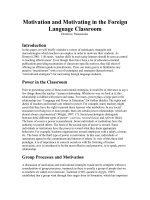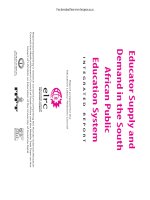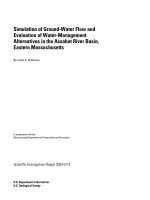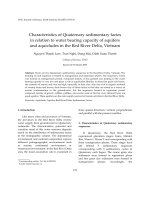Microalgae distribution and diversity in the Narmada river basin around Chutka, Madhya Pradesh, India
Bạn đang xem bản rút gọn của tài liệu. Xem và tải ngay bản đầy đủ của tài liệu tại đây (684.89 KB, 14 trang )
Int.J.Curr.Microbiol.App.Sci (2019) 8(9): 1488-1501
International Journal of Current Microbiology and Applied Sciences
ISSN: 2319-7706 Volume 8 Number 09 (2019)
Journal homepage:
Original Research Article
/>
Microalgae Distribution and Diversity in the Narmada River Basin around
Chutka, Madhya Pradesh, India
Vishal M. Rasal1, Swapnil G. Yadre1, Satya Prakash Shukla1, P. M. Ravi2,
Manish Kumar Mishra2, S. Munilkumar1, Asim Kumar Pal1,
W. S. Lakra1 and Subrata Dasgupta1*
1
ICAR-Central Institute of Fisheries Education, Off Yari Road,
Versova, Mumbai – 400061, India
2
Bhabha Atomic Research Centre, Trombay, Mumbai – 400085, India
*Corresponding author
ABSTRACT
Keywords
microalgae,
diversity, water
parameters,
Narmada, Chutka
Article Info
Accepted:
18 August 2019
Available Online:
10 September 2019
The nutritional needs and ecological niche in food webs make microalgae as
unique indicators for providing practical information of ecosystem condition.
The present study aims to evaluate microalgae distribution and diversity in
relation to physicochemical parameters of Narmada River basin around
Chutka, a proposed place for nuclear power plant installation in Madhya
Pradesh, India. Microalgae number was highest in pre-monsoon followed by
the summer season and reduced in monsoon as well as in winter season. The
seasonal alteration in water parameters markedly influenced microalgae
abundance and diversity. Fifty-four genera belonged to five significant classes
in microalgae were recorded in the Narmada River at different sampling sites
under
study.
The
successive
pattern
of
microalgae
was
Chlorophyceae>Cyanophyceae>Bacillariophyceae> Euglenophyceae. Shannon
diversity indices varied seasonally, and the values indicated the ecosystem was
moderately polluted during monsoon and winter, while highly polluted in the
summer and post-monsoon. The present study reveals continuous deterioration
in the habitat parameters and microalgae diversity due to various
anthropogenic activities in the area of study.
Introduction
Microalgae are mostly primary producers in
aquatic food webs and play crucial roles in
global geochemical cycles (Graham
2009). They play an essential role
global carbon cycle and contribute
50% of the approximately 11–117
1488
et al.,
in the
around
Pg C
Int.J.Curr.Microbiol.App.Sci (2019) 8(9): 1488-1501
assimilated through photosynthesis into
organic matter annually (Behrenfeld et al.,
2001; Falkowski and Raven, 2007).
Microalgae also have an essential role in
global nitrogen cycles (Fowler et al., 2013).
Algae can assimilate dissolved carbon dioxide
and bicarbonate from water for photosynthesis
(Beardall and Raven, 2016). In fisheries and
aquaculture, microalgae serve as essential
food for the larvae and juveniles of fish,
shellfish, and mollusks (Muller-Feuga, 2013).
The nutritional needs and ecological niche in
food webs make microalgae as unique
indicators for providing practical information
of ecosystem condition. Algae provide useful
early warning signals of deteriorating of an
ecosystem and the possible causes. Microalgae
are critical components of the dam biota form
the base of the pyramid of productivity. As the
individual alga or its assemblage has different
physiological requirements, it shows diverse
responses to physicochemical parameters like
temperature, pH, alkalinity, dissolved oxygen,
nitrogen and phosphate contents, etc.
Favourable environment induces excessive
growth and accumulation of microalgae as
blooms lead to the destruction of any water
body resulting in dire consequences. Most
research has focused on the so-called Harmful
Algae Blooms (HABs), especially those who
produce toxins that affect human health.
Microcystin is a kind of microalgae that
produces toxins which if not adequately
treated and used as drinking water, may cause
serious health hazards (Jochimsen et al.,
1998).
Biodiversity and conservation of freshwater
ecosystems have been gaining the attention of
researchers and policymakers for regional
assessments recently since along with their
terrestrial counterparts. Aquatic ecosystems
have been increasingly placed under pressures
to provide renewable resources. Besides,
several factors such as afforestation,
agriculture practices, urban, industrial
development,
river
regulation,
power
generation, exotic species, dumping of solid
wastes, dredging, overfishing invite threats on
biodiversity in terms of conservation status.
Globally the creation of reservoirs by the
construction of medium to large-scale dams
affects the plank tonic and macro-invertebrate
populations due to their complex spatial
structure and notable seasonal fluctuations in
water levels (Henry et al., 1998).
The Narmada River originates near
Amarkantak at about 1050 m above MSL in
the Maikaley highlands, flows westward
through Madhya Pradesh, and Gujarat before
merging with the Gulf of Cambay on the West
coast. The entire Narmada basin is developed
under a comprehensive river valley project
programme through a series of dams. Since
independence, rapid urbanization, agricultural
and industrial development has taken place in
all parts of the Narmada basin. Various
anthropogenic activities across the basin not
only deteriorated the sanctity of the River but
affected abiotic and biotic parameters of the
ecosystem. Recent reports demonstrated an
alarming decline in the diversity of planktons
in the river Narmada (Sharma et al., 2013). As
the Narmada is a rain-fed system and the
annual run-off is dependent on the scale of
water flow in the catchment areas. It is
essential to maintain a suitable flow regime
for managing desired and optimum habitat
conditions in the dam affected river stretches
of the River (Bhowmick et al., 2017). Among
thirty large dams, Bargi dam was constructed
in Madhya Pradesh along the upper zone of
the river. The upper Narmada zone of the river
flows over black granitic rocks. Obstructing
the river course with dams has caused
alterations in basin conditions. Moreover, a
large number of hills and hillocks are present
in the upper valley project areas, resulting in
an uneven depth profile all along the captive
river basin (Bhaumik et al., 2017). Recently
NPCIL and DAE, Govt of India have
1489
Int.J.Curr.Microbiol.App.Sci (2019) 8(9): 1488-1501
proposed the construction of a nuclear power
plant at Chuka village of Mandla district of
Madhya Pradesh. Chutka situated on the right
banks of River Narmada near Bargi Dam
reservoir (Rani Avanti BaiLodhiSagar Dam).
There is plenty and continuous supply of fresh
water for the smooth functioning of a power
plant. The present study has been carried out
from 2012 to 2015 for assessing microalgae
distribution and diversity with relation to
physicochemical parameters of Bargi dam
around Chutka on the Narmada River basin.
Materials and Methods
Study area
Stretch of 39.5km along the Narmada River
around Bargi dam was surveyed using boat.
Seven locations (Table.1 and Fig.1) were
selected for the samples collection on the
basis of approachability and availability of
water throughout the year.
Surface water temperature was measured in
situ using a mercury thermometer. pHwas
measured using a portable instrument
(HANNA meter model 210). Dissolved
oxygen (DO), nitrate-nitrogen, nitriteNitrogen (NO3-N; NO2-N) and phosphatephosphorus (PO4-P) were analyzed as per
standard guidelines and procedures (APHA,
2012).
Collection and analysis of microalgae
Microalgae samples were collected from
seven locations along the course of the River,
as mentioned in Fig 1. Plankton net with a
mouth aperture of 200 mm and mesh size of
25 μm was used to collect the microalgae. The
samples filtered following the procedures
described by Steedman (1976). A known
volume (60 L) of water was collected from
different spots of the location on the boat
using the net.
Sampling sites were selected in a way, that it
covered maximum habitats including shallow
with rapid flow, deep with slow flowing water
and lentic water (reservoir).
All samples preserved in five percent formalin
and few drops of Lugol’s iodine solution was
added and kept in a cold room in the dark for
further analysis (Eaton et al., 2005). For
qualitative analysis of the microalgae, random
sub-samples placed on a slide for observation
using an optical microscope.
The sampling stations such as, Patha and
Kikramal were located upstream to Chutka,
whereas four stations such as, Tatighat,
Poudimal, Bargi, and Tewar were situated at
the downstream to Chutka (Fig. 1).
For quantitative analysis, Sedgwick-Rafter
counting cell (50 x 20 x 1 mm) was used for
counting the number of cells per liter.
Microalgae were identified by consulting texts
(Perry, 2010; Ruggiero et al., 2015).
Analysis of Physicochemical parameters of
water
Statistical Analysis
Selected physicochemical parameters were
analyzed in different seasons such as summer
(16, March to 15, June), monsoon (16, June to
15, September), post-monsoon (16 September
to 15, December) and winter (16 December to
15, March) during 2012 to 2015.
Analysis Of Variance (ANOVA) and
correlation for the water parameters and
microalgae abundance was done using SPSS.
Primer 5 (version 5.2.9), and Biodiversity Pro
(version 2) were used to determine the
diversity of the microalgae among sampling
stations.
1490
Int.J.Curr.Microbiol.App.Sci (2019) 8(9): 1488-1501
Results and Discussion
Physical and chemical characteristics of
water
The mean surface water temperature ranged
between 21.5±3.26°C and 24.0±3.48 °C. The
maximum and minimum temperature was
recorded at Tewar and Chutka respectively
and did not vary (P >0.05) further in the
upstream locations (Fig. 2A). The seasonal
temperature showed significant wide variation
(P <0.05) between 16.7°C and 31.8 °C in the
winter and summer season (Fig. 2B).
Temporal change in ambient temperature,
though not very apparently, has been erratic
and higher in the years of drought and low
river discharge (Bhaumik et al., 2017).
The highest and lowest mean DO values
ranged between 6.3 ±0.37 mg/L and 8.05 ±
0.29 mg/L at Paudimal and Tewar,
respectively. The DO values at other locations
did not vary significantly and remained
between 6.56 ± 0.22 mg/L and 6.99±0.86
mg/L (Fig. 3A). Analysis of variance showed
that there were no statistically significant
variations in dissolved oxygen (DO) values
among different seasons except monsoon,
which were significantly lower (p<0.05) (Fig.
3B). The dissolved oxygen at the five
sampling stations along the Narmada River
fluctuated between 3.1 and 6.5 mg/l and low
concentration of dissolved oxygen (DO) was
reported in summer (Saini et al., 2015).
Bhaumick et al., (2017) reported the level of
dissolved oxygen fluctuated over a wide range
(4.4–9.1 ppm) in the middle and lower zones
of the Narmada.
A circum-neutral pH was observed during the
study period, with the highest average value of
7.5±0.15 and the lowest of 7.15±0.15 at
Tatighat and Paudimal, respectively (Fig. 3A).
The seasonal temperature showed significant
variation (P<0.05) between post-monsoon
(7.54±0.05) and the rest of the seasons (7.24-
7.31) (Fig. 3B). The pH of Narmada water
showed alkaline condition during the period
and ranged between 6.6 and 9.5 at the five
different sites (Saini et al., 2015).
The average alkalinity values ranged between
113.2± 0.51 mg/L and 115.87±0.48 mg/L at
different locations with a maximum value at
Patha and minimum at Zero Tanky (Fig. 4A).
The seasonal alkalinity values were in the
range of 114.15±0.39 mg/L to 115.25±0.61
mg/L, and there was no significant variation in
the values among different seasons (Fig.4B).
The hardness values ranged between 76.55±
1.57 mg/L and 113.12±1.89 mg/L and showed
significant fluctuations (p<0.05) among
different sampling sites (Fig. 4A). The highest
and lowest values were recorded at Zero
Tanky and Kikra, respectively. The hardness
values in different seasons did not vary
significantly (p>0.05) (Fig. 4B). Alkalinity
was highest in monsoon and low in winters,
but no regular trend was observed with mean
values of 136.66± 55.84 in Narmada River at
Dograwada Ghat (Sharma et al., 2015). Total
hardness varied from 79 – 196 mg/l and the
highest peak observed in May (196 mg/l) and
lowest in July (79 mg/l) in Dograwada Ghat
(Sharma et al., 2015).
The highest NO3-N value recorded was 0.52
±0.025 mg/L and the lowest of 0.15 ±0.03
mg/L at Tatighat and Tewar, respectively. The
mean values were not significantly different
(p>0.05) among most of the sampling sites,
except Tewar and Patha (Fig. 5A).
The values in different season ranged between
0.38 ±0.05 and 0.47 ±0.05 mg/L and did not
show a significant difference among the
seasons (Fig. 5B). The NO2-N values showed
similar levels and locational changes as
recorded for NO3-N. The highest content of
NO2-N was 0.56 ±0.03 mg/L at Tatighat,
while the lowest was noted at Tewer (0.2
1491
Int.J.Curr.Microbiol.App.Sci (2019) 8(9): 1488-1501
±0.01 mg/L, Fig. 5A). Results from ANOVA
showed that the observed seasonal variations
were not significant among different seasons
(P>0.05; Fig. 5B). The nitrate nitrogen on an
average annual basis recorded in the range of
0.13 mg/L to 0.30 mg/L with a mean value of
0.215mg/l during winter and post-monsoon
seasons in the Narmada at Sethianghat (Bano
et al., 2016). PO4-P showed the highest mean
concentration of 0.82 ±0.01 mg/L at Patha,
whereas the lowest value was recorded at
Tewar (0.28 ±0.01 mg/L; Fig. 5A). The PO4-P
value of 0.49 ±0.04 mg/L was recorded in
monsoon, while the highest of 0.64±0.06
mg/L was recorded in post-monsoon (Fig.
5B).
The PO4-P values were not significantly
different among winter, summer, and
monsoon (Fig. 5B). Very high NO3-N and
PO4-P ranged from 11.1-26.5 mg/l, and 1.043.58 mg/l respectively were reported from the
five different sites along the Narmada River
(Saini et al., 2015). Mean phosphate
concentration of river Narmada was recorded
in the range of 0.01 to 0.04 mg/L during
winter and summer seasons at Sethiaghat
(Bano et al., 2016).
Composition of phytoplankton
Communities
The microalgae community in Narmada River
around the Bargi dam consisted of
Bacillariophyceae, Chlorophyceae, Cyanophyceae, Chrysophyceae, and Dinophyceae
(Fig. 6). Total fifty-four genera identified
during the sampling period, out of those 16
genera belonged to Bacillariophyceae, while
Chlorophyceae and Cyanophyceae represented
by 21and 10 genera respectively, whereas the
Chrysophyceae and Euglenophyceae were
represented by 2 genera each, while 3 genera
belonged to Dinophyceae (Table 2). Out of all
the genera, thirty one were present in all
samplings and considered for statistical
analysis. The previous study reported 13
genera of Chlorophyceae, 5 genera of
Bacillariophyceae, 8 genera Cyanophyceae,
and 1 genera of Euglenophyceae at the
Dograwadaghat of River Narmada (Sharma et
al., 2011).
Table.1Geographical locations and physiography of sampling sites
Serial no.
Latitude (°E)
S1
Sampling
Points
Tewar
Physiography
22°97’.071
Longitude
(°N)
79°87’.919
S2
Zero tanky
22°92’79
79°90’235
Reservoir
S3
Poudimul
22°84’774
80°01’284
Deep/ slow flowing
S4
Tatighat
22°76’93
80°08’368
Deep/ slow flowing
S5
Chutaka
22°78’213
80°09’301
Reservoir
S6
Patha
22°84’774
80°01’284
Reservoir
S7
Kikara mal
22°77’552
80°18’989
Deep
slow flowing
1492
Shallow &rapids
Int.J.Curr.Microbiol.App.Sci (2019) 8(9): 1488-1501
Table.2 Microalgae genera recorded in the Narmada River at seven locations.
Cyanophyceae
(10)
Anabanea sp.
Dinophyceae
(3)
Peridinium sp.
Chlorophyceae (21)
Chrysophyceae
(2)
Synura sp.
Euglenophyceae
Gonium sp.
Bacillariophyceae
(16)
Fragilaria sp.
Anacystis sp.
Urosolenia sp.
Mougeotia sp.
Pinnularia sp.
Dinobryon sp.
Euglena sp.
Chlorococcus sp.
Ceratium sp.
Microspora sp.
Tabellaria sp.
Merismopedia sp.
Cosmarium sp.
Gomphonema sp.
Microcystis sp.
Tetraspore sp.
Nodularia sp.
Nostoc sp.
Chlamydomonas sp.
Amphora sp.
Oscilatoria sp.
Euastridium sp.
Netzschia sp.
Phormidium sp.
Eudorina sp.
Lyngbya sp.
Spirulina sp.
Cosmarium sp.
Synendra sp.
Cyclotella sp.
Lepocinclis sp.
Thalassionema sp.
Actinastrum sp.
Gyrosigma sp.
Crucigenta sp.
Diatom asp.
Cladophoroa sp.
Gonicloris sp.
Ulothrix sp.
Cymbella sp.
Pediastrum sp.
Pseudonetzchia sp.
Closterium sp.
Aulacoseira sp.
Scenendesmus sp.
Staurastrum sp.
Oedogonium sp.
Volvox sp.
Chlorella sp.
1493
Phacus sp.
Int.J.Curr.Microbiol.App.Sci (2019) 8(9): 1488-1501
Fig.1.Portal map of sampling locations along the Narmada River around Chutka
Fig.2.Locational and seasonal variation of water temperature in Narmada. Values are
mean±SEM. Different letters depict statistically significant (p<0.05)
Fig.3. Spatial and temporal changes in dissolved oxygen (DO) and pH of water during study
period. Values are mean±SEM. Different letters donote significant difference (p<0.05)
1494
Int.J.Curr.Microbiol.App.Sci (2019) 8(9): 1488-1501
Fig. 4.Variation of alkalinity and hardness in the Narmada water at different sampling sites and
seasons. Values are mean±SEM. Different letters depict significant difference (p<0.05)
Fig.5 Variation of phosphate-phosphorus (PO4-P), nitrate-nitrogen (NO3-N), nitrite-nitrogen
(NO2-N) in the Narmada water at different sampling sites and seasons. Values are mean±SEM.
Different letters depict significant difference (p<0.05).
Fig.6.Seasonal variation of individual microalgae group
1495
Int.J.Curr.Microbiol.App.Sci (2019) 8(9): 1488-1501
Fig.7 Composition of microalga community (7A) and seasonal variation in abundance of
microalgae (7B).
Fig.8 Microalgae diversity in different seasons
Fig.9 Similarity of microalgae community during different seasons
1496
Int.J.Curr.Microbiol.App.Sci (2019) 8(9): 1488-1501
A detailed study conducted by Unni (1996) on
the Narmada River along 500 km stretch
between Amarkantak and Sethanighat reported
a total of 174 species of phytoplankton. Out of
the total, 101 species in 27 genera belonged to
Bacillariophyceae, while 46 species in21
genera were Chlorophyceae. Cyanophyceae,
Euglenophyceae, Dinophyceae were represented by19, 4, and 3 species, respectively,
and Chrysophyceae was repre-sen-ted by a
single species. A recent report revealed that
four families represented the phytoplankton
community in the River Narmada near
Jabalpur. Bacillariophyceae is the most
diverse family consist of 10 species with 559
organisms (46%), while Chlorophyceae had
409 organisms (34%) belonged to 8 species.
Cynophyceae consisted of 216 organisms
(18%) belonged to 6 species and
Euglenophyceae had 22 organism (2%) of 1
species in a six-month study during July to
December 2015 (Rai et al., 2016).
Seasonal and locational
microalgae abundance
variations
in
The percentage contribution of the four major
groups of microalgae varied from place to
place and with the time and was related to
various abiotic factors. In the present study,
Chlorophyceae and Cynophyceae shared
56.3% and 29.7% respectively, while
Bacillariophyceae and Dinophyceae contributed 12.7 and 1.3 % in the total population
(Fig. 7A).
The similar trends of succession such as,
Chlorophyceae>Cyanophyceae>Bacillariophy
ceae>Euglenophyceae(Fig. 6) in microalgae
community were noticed in the earlier studies
on the Narmada River basin time to time
(Sharma et al., 2011; Sharma et al., 2015).
However, different succession with a
dominant group as Bacillariophyceae was
recorded from the mixed zone of Narmada
River (Saini et al., 2015, Rai et al., 2016). The
average microalgae density showed significant
differences (p<0.05) among the seasons. The
abundance was highest in pre-monsoon season
(6710 cells/L), followed by summer (5562.7
cells/L), monsoon (2537.1 cells/L) and winter
3029.4 cells/L) (Fig.7B). The total number of
microalgae in different stretches of the
Narmada River was recorded in the range of
317-751 cells/L in along the stretch of
Lamhetaghat to Bhedaghat near Jabalpur
(Saini et al., 2015), 1206 cells/L at Jabalpur
region (Rai et al., 2016), and 1458-1505
units/L in four locations along the River basin
(Sharma et al., 2015).
Correlation
microalgae
of
water parameters
and
Significant correlations were calculated
between microalgae density and water
parameters at different locations. The overall
microalgae and Dianophyceae abundances
showed a highly significant and positive
correlation with temperature (r = 0.88 and r =
0.92) similar to the earlier report (Sharma et
al., 2015). Contrary, negative correlation (r =
0.97) existed between nitrite-nitrogen and total
phytoplankton. The Chlorophyceae, Cyanophyceae, and Bacillariophyceae density
showed a significant and positive correlation
with nitrate-nitrogen (r = 0.71-0.85) and
phosphate (r = 0.81-0.93) as reported in
Tungabhadra and Ogun River (Suresh, 2015;
Odulate et al., 2017). Thus, NO3 and total
phosphate are nutrients for phytoplankton
growth, whereas all the groups showed a
negative correlation with nitrite-nitrogen.
Nitrate-nitrogen showed positive correlation (r
= 0.98) with PO4. Saravi et al., (2011)
suggested that the majority of phytoplankton
species have large tolerance to fluctuating
water quality, which varies from year to year.
Seasonal
diversity
community
in
microalgae
Overall microalgae diversity was recorded in
the range of 0.487 to 1.354 during different
1497
Int.J.Curr.Microbiol.App.Sci (2019) 8(9): 1488-1501
seasons in the Narmada River around Chutka.
Seasonal
Shannon
diversity
indices
represented the most diverse community in the
winter season (1.354), followed by monsoon
(1.24) and summer (0.994) and least varied in
post-monsoon (0.487; Fig. 8). Although
similar seasonal diversity pattern was reported
in Sular Lake, Coimbatore, however, the
diversity values were comparatively higher
than the present study (Mancikam et al.,
2017). Microcystisis, one of the dominant
genera, contains several species which often
form massive blooms and which produce
toxins (Borowitzka, 2018). The Microcystis
has been expanding worldwide mainly due to
eutrophication of ponds, lakes, and rivers,
often together with increased temperatures,
and have significant environmental and human
and animal health impacts (Carmichael and
Boyer, 2016). In the present study,
Microcystis bloom developed in the postmonsoon season showed a negative
correlation (r = - 0.83) with the microalgae
diversity, indicates that the Microcystis bloom
was a post-monsoon phenomenon and harmed
variety of microalgae.
The evenness of microalgae community was
comparatively higher in post-monsoon season
(0.645), and the value decreased abruptly in
summer through monsoon and reached lowest
limit in winter (Fig. 8). The overall species
evenness of phytoplankton was recorded in the
range between 0.76 and 0.97 in Sulur lake
waters (Manickam et al., 2017).
Bray-Curtis similarity cluster analysis was
done to evaluate similarities among the
microalgae community of the different
seasons. The investigation revealed that there
was a significant difference among the seasons
in microalgae community compositions (Fig.
9). The similarity was most notable in postmonsoon and monsoon (94.39%) compared to
summer (85.49%; (Fig. 9).
Shannon-Wiener diversity index (H') is a
common indicator for evaluating pollution
level in an aquatic system. Wilm and Dorris
(2007) suggested a relationship between
species diversity and pollution status of
aquatic system and classified as follows; > 3 =
clean water, 1-3 = moderately-polluted,< 1 =
heavily polluted. In the present study (H')
value ranged between 0.487 and 1.35 (Fig. 8),
suggested that the locations were moderately
polluted during monsoon and winter, while
highly polluted in the summer and postmonsoon. The probable reasons for pollution
include high microalgae abundance in the
post-monsoon and too some extent in summer.
In addition, stable hydrological factors and
low water level may be responsible for
summer bloom, whereas agricultural and
waste run-off attributed to nutrient enrichment
and microalgae bloom in the post-monsoon
season. Perturbation of a lotic aquatic
ecosystem may not be precisely quantified
based on the Shannon-Wiener species
diversity of microalgae communities in the
fluviatile environment since those organisms
may be of allochthonous in origin despite been
detected in situ even in highly polluted zone
(Jhingran et al., 1989).
The present study provides baseline
information on microalgae distribution,
abundance, diversity, and evenness in the
River Narmada around the Chutka, a proposed
area for installing a nuclear power plant
shortly. Microalgae number was highest in
pre-monsoon followed by the summer season
and reduced in monsoon as well as in winter
season. The results reveal that seasonal
alteration in water parameters influenced
microalgae abundance and diversity. Fiftyfour genera belonged to five significant
classes in microalgae were recorded in River
water. The successive pattern of microalgae
was
as
Chlorophyceae>Cyanophyceae>
Bacillariophyceae>Euglenophyceae during the
period of study. Shannon diversity indices
varied seasonally, and the values indicated the
1498
Int.J.Curr.Microbiol.App.Sci (2019) 8(9): 1488-1501
ecosystem was moderately polluted during
monsoon and winter, while highly polluted in
the summer and post-monsoon. The present
study reveals deterioration in the habitat
parameters and microalgae diversity due to
various anthropogenic activities in the area of
study.
Acknowledgement
The authors are thankful to the Director,
ICAR-Central Institute of Fisheries Education,
Mumbai for providing all the facilities to carry
out this work. This research was funded by
BRNS, DAE, Govt. of India, Mumbai under
the project no. 2010/36/84-BRNS/dt2/2/11.
References
Perry,] R. (2003). A Guide to the marine
plankton of southern California
[online],
/>APHA (American Public Health Association),
2012. Standard Methods for the
Examination
of
Water
and
Wastewater, 22nd ed. American Public
Health Association, Washington, DC.
Bano, Z., Chauhan, R. And Bhatt, N.A.
(2015). A study of seasonal
physicochemical arameters in River
Narmada. JCBPS, 6 (1), 010-017.
Beardall, J., Raven, J.A., 2016. Carbon
acquisition
by
microalgae.
In:
Borowitzka, M.A., Beardall, J., Raven,
J.A. (Eds.), The Physiology of
Microalgae. Springer, Dordrecht, pp.
89–90.
Behrenfeld, M.J., Randerson, J.T., McClain,
C.R., Feldman, G.C., Los, S.O.,
Tucker, C.J., Falkowski, P.G., Field,
C.B., Frouin, R., Esaias, W.E., Kolber,
D.D., Pollack, N.H., 2001. Biosperic
primary production during an ENSO
transition. Science 291, 2594–2597.
Bhaumik, U., Mukhopadhyay, M. K.,
Shrivastava, N. P., Sharma, A. P. and
Singh, S.N. (2017) A case study of the
Narmada River system in India with
particular reference to the impact of
dams on its ecology and fisheries,
Aquatic
Ecosystem
Health
&
Management, 20:1-2,151-159.
Borowitzka, M.A. (2018). Biology of
Microalgae. In: Ira A. Levine, I.A., and
Fleurence, J., (Eds.), Microalgae in
Health and Disease Prevention,
Academic Press, Pages 23-72.
Carmichael, W.W., Boyer, G.L., 2016. Health
impacts from cyanobacteria harmful
algae blooms: implications for the
North American great lakes. Harmful
Algae 54, 194–212.
Eaton, A.D., Clesceri, L.S., Rice, E.W.,
Greenberg, A.E., Franson, M.A.H.
(2005). (Eds.). Standard Methods for
the Examination of Water and
Wastewater: Centennial Edition, first
ed.
American
Public
Health
Association, Washington, D.C, 1368.
Falkowski, P.G., Raven, J.A., 2007. Aquatic
Photosynthesis, second ed. Princeton
University Press, Princeton, NJ.
Fowler, D., Coyle, M., Skiba, U., Sutton,
M.A., Cape, J.N., Reis, S., Sheppard,
L.J., Jenkins, A., Grizzetti, B.,
Galloway, J.N., Vitousek, P., Leach,
A., Bouwman, A.F., Butterbach-Bahl,
K., Dentener, F., Stevenson, D.,
Amann, M., Voss, M., 2013. The
global nitrogen cycle in the twentyfirst
century.
Philosophical
Transactions of the Royal Society B:
Biological Sciences 368.
George FA, Dimowo BO. Water quality in
relation to plankton abundance and
diversity in river Ogun, Abeokuta,
Southwestern Nigeria. Int J Env Health
Eng. 6:3.
1499
Int.J.Curr.Microbiol.App.Sci (2019) 8(9): 1488-1501
Graham, L.E., Graham, J.M., Wilcox, L.W.,
2009. Algae. Benjamin Cummings,
San Francisco.
Henry, R., Nunes, M. A., Mitsuka, P. M.,
Lima, N., Casanova, RSMC. (1998).
Variaçãoespacial e temporal da
produtividadeprimáriapelofitoplâncton
naRepresade
Jurumirim
(Rio
Paranapanema, SP). RevistaBrasileira
de Biologia = Brazilian Journal
ofBiology, 58 (4), 571-590.
Jhingran, V.G., Ahmad, S.H. and Singh. A.K.
(1989). Application of Shannon–
Wiener index as a measure of pollution
of river Ganga at Patna, Bihar, India.
Current Science, 58, No. 13, 717-720.
Jochimsen, E.M., Carmichael, W.W., An, J.,
Cardo, D.M., Cookson, S.T., Holmes,
C.E.M., Antunes, M.B., de MeloFilho,
D.A., Lyra, T.M., Barreto, V.S.T.,
Azevedo, S.M.F.O., Jarvis, W.R.,
1998. Liver failure and death after
exposure to microcystins at a
hemodialysiscenter in Brazil. New
England Journal of Medicine 338,
873–878.
Manickam N., Saravana Bhavan P.,
Santhanam P., Bhuvaneswari, R. and
Chitrarasu P. (2017). Physicochemical
characteristics and phytoplankton
biodiversity
in
Sulurlake
of
Coimbatore, South India. Res. J.
Biotech 12 (11), 72-82.
Muller-Feuga, A., 2013. Microalgae for
aquaculture: the current global
situation and future trends. In:
Richmond, A., Hu, Q. (Eds.),
Handbook of Microalgal Culture:
Applied
Phycology
and
Biotechnology. Wiley-Blackwell, pp.
615–627.
Odulate D.O., Omoniyi I.T., Alegbeleye
W.O., George F.A., Dimowo B.O.
(2017). Water quality in relation to
plankton abundance and diversity in
river Ogun, Abeokuta, South western
Nigeria. Int J Env Health Eng 6:3.
Ruggiero, M.A., Gordon, D.P., Orrell, T.M.,
Bailly, N., Bourgoin, T., Brusca, R.C.,
Cavalier-Smith, T., Guiry, M.D., Kirk,
P.M., 2015. A higher level classification of all living organisms. PLoS
One 10, e0119248.
Saini, D., Dube, K.K., Shrivastava S.B., and
Pandey, A.K. (2015). Seasonal and
diel variations in plankton production
in relation to physicochemical
parameters and its impact on fisheries
in river Narmada from Lamhetaghat to
Bhedaghat near Jabalpur (Madhya
Pradesh). J. Exp. Zool. India Vol. 18,
951-960.
Saravi, H.N., Maklough A., Pourgholam R.,
Din Z., Foong S.Y. 2011. Multivariate
analysis of water quality parameters
and phytoplankton composition in the
southern of Caspian Sea. International
Aquatic Research. ISSN 2008-4935.
Int. Aquat. Res. (2011) 3: 205 - 216
Sharma, J., Parashar, A., Bagre, P., Qayoom, I.
(2015). Phytoplanktonic Diversity and
Its Relation to Physicochemical
Parameters
of
Water
at
DogarwadaGhat of River Narmada.
Current World Environment Vol.
10(1), 206-214 (2015)
Sharma, S., Singh, K., Prajapati, R., Solnki,
C.M., Sharma, D., TaniyaSengupta,
T., Gandhi, T., Chouhan, M. and Vyas,
A. (2011). Diversity and Seasonal
Abundance of Phytoplankton of River
Narmada Madhya Pradesh (India).
World Rural Observations 3(2):14-28
Sharma, S., Solanki, C.M. Sharma, D., Tali, i.
(2013). Population dynamics of
Planktons in river Narmada at
Omkareshwar. International Journal of
Advanced Research 1, Issue 1, 11-15.
ShivaniRai, Arjun Shukla, Bhoopendra Kumar
Ahirwar (2016). Plankton diversity,
seasonal variation and population
1500
Int.J.Curr.Microbiol.App.Sci (2019) 8(9): 1488-1501
dynamics in river Narmada at Jabalpur
region (M.P.). IJCAS, Vol. 6, Issue, 4,
11-16
Steedman H. F. (1976). Zooplankton fixation
and preservation. Unesco Press,
France,
Suresh,
B.
(2015)
Multiplicity
of
phytoplankton
diversity
in
Tungabhadra River near Harihar,
Karnataka (India).
International
Journal of Current Microbiology and
Applied Sciences 4(2), 1077-1085
Unni, K.S., 1996. Ecology of river Narmada.
A.P.H. Publishing, New Delhi.
Wilm, J.L. and Dorris, T.C. (2007). Species
Diversity
of
Benthic
Macroinvertebrates. In: A Stream Receiving
Domestic and Oil Refinery Effluents.
In: Islam, S.M. Phytoplankton
diversity index with reference to
mucalinda serovar Bodh-Gaya, 12th
World Lack Conference., Taal, India.
How to cite this article:
Vishal M. Rasal, Swapnil G. Yadre , Satya Prakash Shukla, P. M. Ravi, Manish Kumar Mishra,
S. Munilkumar, Asim Kumar Pal, W. S. Lakra and Subrata Dasgupta. 2019. Microalgae
Distribution and Diversity in the Narmada River Basin around Chutka, Madhya Pradesh, India.
Int.J.Curr.Microbiol.App.Sci. 8(09): 1488-1501. doi: />
1501









